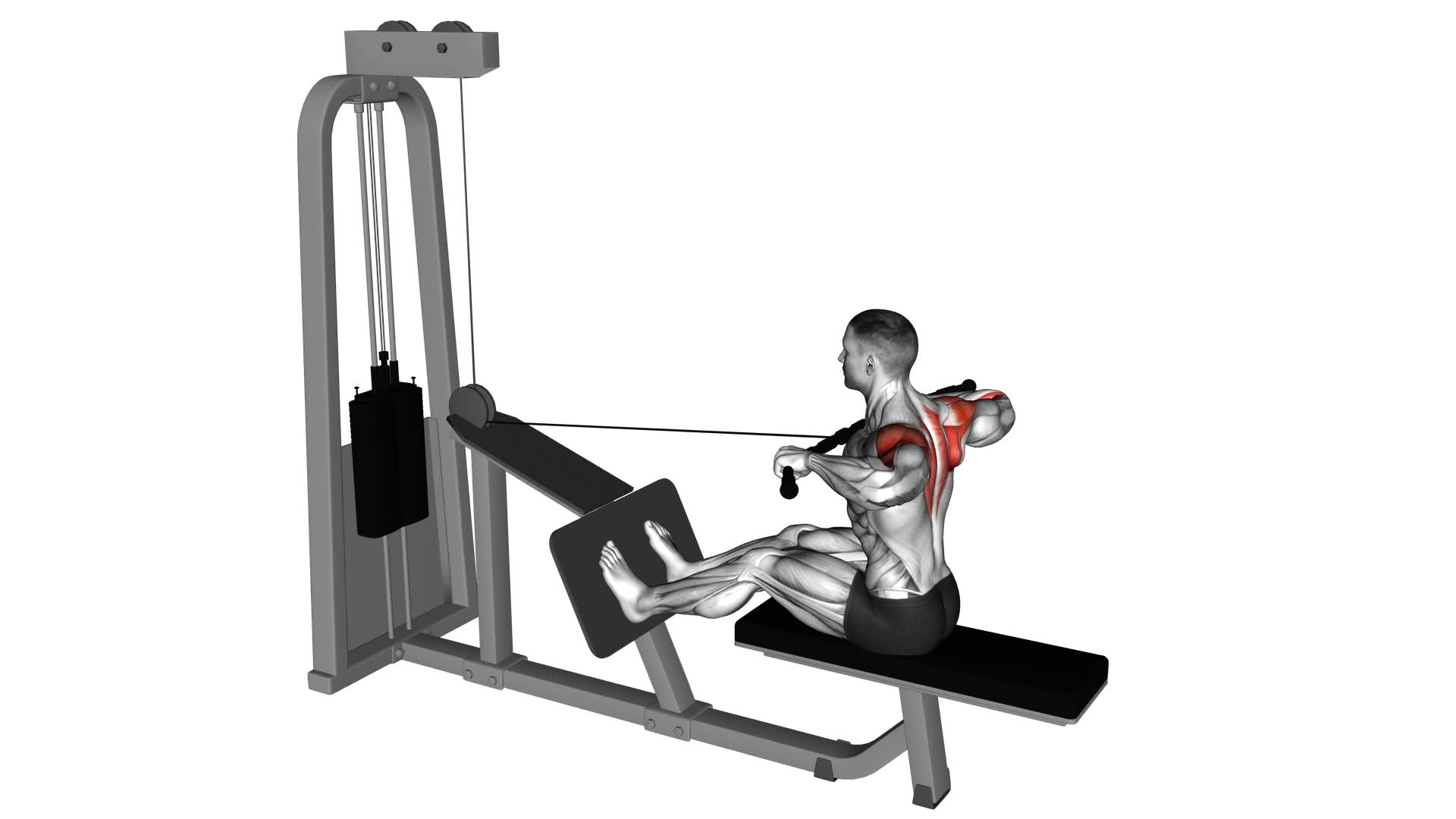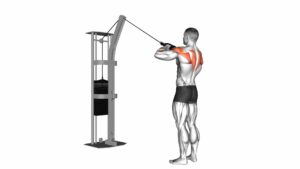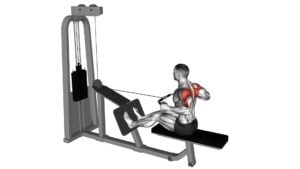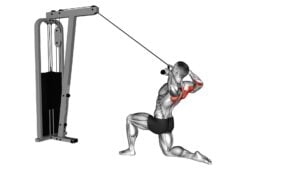Cable Rear Delt Row – Video Exercise Guide & Tips

Are you looking to strengthen your rear deltoids and improve your upper body strength? Look no further than the cable rear delt row!
Watch This Exercise Video
This exercise targets the muscles in your shoulders, helping you build a strong and defined back.
In this video exercise guide, we'll walk you through the proper form and technique, as well as provide helpful tips to maximize your results.
Get ready to take your workouts to the next level with the cable rear delt row!
Key Takeaways
- The cable rear delt row targets and strengthens the rear deltoids, rhomboids, and trapezius muscles.
- It improves muscle development and flexibility in the upper back and shoulders.
- The recommended frequency for optimal results is 1-2 times per week.
- Proper form and technique, such as initiating the movement with the rear deltoids and keeping the back straight, are crucial for maximizing benefits and avoiding injury.
Benefits of the Cable Rear Delt Row
The Cable Rear Delt Row offers a multitude of benefits for your upper back and shoulder muscles. When performing this exercise, you can expect to activate and strengthen the muscles in your rear deltoids, rhomboids, and trapezius. The rear deltoids are responsible for pulling your arm backward and outward, while the rhomboids and trapezius help with scapular retraction and stabilization.
One of the key benefits of the Cable Rear Delt Row is its ability to target and activate these specific muscles. By using the cable machine, you can ensure consistent resistance throughout the entire range of motion, resulting in optimal muscle activation. This exercise also allows for a greater range of motion compared to other rowing exercises, which can lead to improved muscle development and flexibility in the upper back and shoulders.
In terms of training frequency, it's recommended to incorporate the Cable Rear Delt Row into your upper body workout routine 1-2 times per week. This frequency allows for adequate rest and recovery between sessions, while still providing enough stimulus for muscle growth. As with any exercise, it's important to start with lighter weights and gradually increase the resistance as your strength improves.
Proper Form and Technique
To properly perform the Cable Rear Delt Row, you should position yourself in front of the cable machine with your feet shoulder-width apart and grasp the handles with an overhand grip. This exercise primarily targets the rear deltoids, which are the muscles located at the back of your shoulders.
To begin, stand facing the machine with your arms extended in front of you, maintaining a slight bend in your elbows. Keep your back straight and your core engaged throughout the movement. As you exhale, pull the handles toward your body, squeezing your shoulder blades together. Focus on using your rear delts to initiate the movement, rather than relying on your arms or back muscles.
When it comes to weight and reps, it's recommended to start with a lighter weight and gradually increase as you get stronger and more comfortable with the exercise. Aim for 3-4 sets of 8-12 reps, ensuring that you maintain proper form and control throughout each repetition.
Equipment and Set-Up
For the Cable Rear Delt Row exercise, you'll need a cable machine and handles. The cable machine is a versatile piece of equipment that allows you to perform a variety of exercises targeting different muscle groups.
When setting up for the Cable Rear Delt Row, first adjust the cable machine to a height that allows you to comfortably grasp the handles. Attach the handles to the cable machine, making sure they're secure and stable. Stand facing the cable machine with your feet shoulder-width apart and your knees slightly bent. Grab the handles with an overhand grip, palms facing down. Your arms should be fully extended in front of you, with a slight bend in your elbows. This is your starting position.
If you don't have access to a cable machine, there are alternative exercises you can do to target the rear deltoids. Some of the best cable row alternatives include bent over dumbbell rows, seated cable rows, and bent over barbell rows. These exercises can be done with dumbbells, a barbell, or a resistance band, depending on the equipment you have available.
Incorporating these exercises into your routine will help you develop strong and well-defined rear deltoids. Remember to always use proper form and technique to maximize the effectiveness of your workouts and prevent injury.
Variations and Progressions
To add variety and challenge to your Cable Rear Delt Row exercise, try incorporating different variations and progressions. These advanced techniques can help to further activate your muscles and enhance your overall workout.
One variation you can try is the single-arm cable rear delt row. Instead of using both arms simultaneously, you'll focus on one side at a time. This variation helps to isolate each side of your rear delts, allowing for better muscle activation and development.
Another progression you can incorporate is the seated cable rear delt row. By sitting on a bench or chair instead of standing, you're able to stabilize your body and solely focus on targeting your rear delts. This variation also helps to reduce the involvement of other muscle groups, ensuring a more targeted workout.
Furthermore, you can increase the challenge by using heavier weights or resistance bands. By gradually increasing the resistance, you're pushing your muscles to adapt and grow stronger. This progression not only improves muscle activation but also enhances overall strength and power.
Incorporating these variations and progressions into your Cable Rear Delt Row exercise routine won't only add variety but also maximize muscle activation and help you achieve better results. Remember to start with proper form and gradually increase the difficulty to avoid injury and ensure continuous progress.
Common Mistakes to Avoid
Avoiding common mistakes is crucial for maximizing the effectiveness of your Cable Rear Delt Row exercise. To ensure proper execution, it's important to be aware of these common mistakes and how to avoid them.
One common mistake is using too much weight. It's important to start with a weight that allows you to maintain proper form throughout the exercise. Using too much weight can lead to improper technique and potential injury. Focus on using a weight that challenges you without compromising your form.
Another common mistake is using momentum to complete the movement. It's important to perform the exercise in a controlled manner, using your rear deltoids to initiate and control the movement. Avoid using excessive swinging or jerking motions, as this takes away from the effectiveness of the exercise.
Proper posture is also crucial. Many people tend to round their shoulders or hunch their backs during this exercise. To avoid this mistake, keep your chest up, shoulders back, and spine in a neutral position. This will ensure that you're targeting the intended muscles and avoiding unnecessary strain on other areas of your body.
Frequently Asked Questions
How Often Should I Perform the Cable Rear Delt Row Exercise?
To determine how often you should perform the cable rear delt row exercise, consider your fitness goals and current fitness level.
It's generally recommended to include this exercise in your weekly routine for balanced shoulder development.
However, it's important to consult with a qualified professional, especially if you have a back injury.
They can modify the exercise to suit your needs and ensure you're performing it safely and effectively.
Can the Cable Rear Delt Row Be Modified for Individuals With Shoulder Injuries?
If you have a shoulder injury, modifying the cable rear delt row exercise can help. There are alternative exercises that focus on strengthening the rear deltoids without putting too much strain on your shoulders.
By using lighter weights or resistance bands, you can still target the same muscle group while reducing the risk of further injury.
It's important to consult with a professional or physical therapist to determine the best modifications for your specific condition.
Is It Necessary to Warm up Before Performing the Cable Rear Delt Row?
To ensure a safe and effective workout, it's important to warm up before performing the cable rear delt row. Warming up helps increase blood flow to your muscles, making them more flexible and less prone to injury.
Additionally, it prepares your body for the upcoming exercise by activating the muscles you'll be targeting.
If you're unable to perform the cable rear delt row, there are alternative exercises such as dumbbell rear delt rows or band pull-aparts that can provide similar benefits.
How Can I Incorporate the Cable Rear Delt Row Into a Full Upper Body Workout Routine?
To incorporate the cable rear delt row into your full upper body workout routine, start by understanding the benefits of cable exercises.
Cable exercises provide constant tension on the muscles, helping to build strength and improve muscle definition.
To integrate the cable rear delt row, consider performing it after compound exercises like bench press or overhead press.
This exercise targets the rear delts, upper back, and traps, helping to improve posture and enhance overall upper body strength.
Are There Any Specific Breathing Techniques I Should Follow While Performing the Cable Rear Delt Row?
When performing the cable rear delt row, it's important to pay attention to your breathing technique. This can help you maintain proper form and maximize the effectiveness of the exercise.
Take a deep breath in before you start the movement and exhale as you pull the cable towards your body. This helps to engage your core and stabilize your body.
If you have a shoulder injury, you may need to modify the exercise and consult with a professional for guidance.
Conclusion
In conclusion, the cable rear delt row is an effective exercise for targeting the rear deltoid muscles in your shoulders. By using proper form and technique, you can maximize the benefits of this exercise.
Whether you're a beginner or advanced lifter, there are variations and progressions available to suit your fitness level. However, it's important to avoid common mistakes that can hinder your progress.
Incorporate the cable rear delt row into your workout routine for stronger and more defined shoulders.

Author
Years ago, the spark of my life’s passion ignited in my mind the moment I stepped into the local gym for the first time. The inaugural bead of perspiration, the initial endeavor, the very first surge of endorphins, and a sense of pride that washed over me post-workout marked the beginning of my deep-seated interest in strength sports, fitness, and sports nutrition. This very curiosity blossomed rapidly into a profound fascination, propelling me to earn a Master’s degree in Physical Education from the Academy of Physical Education in Krakow, followed by a Sports Manager diploma from the Jagiellonian University. My journey of growth led me to gain more specialized qualifications, such as being a certified personal trainer with a focus on sports dietetics, a lifeguard, and an instructor for wellness and corrective gymnastics. Theoretical knowledge paired seamlessly with practical experience, reinforcing my belief that the transformation of individuals under my guidance was also a reflection of my personal growth. This belief holds true even today. Each day, I strive to push the boundaries and explore new realms. These realms gently elevate me to greater heights. The unique combination of passion for my field and the continuous quest for growth fuels my drive to break new ground.







